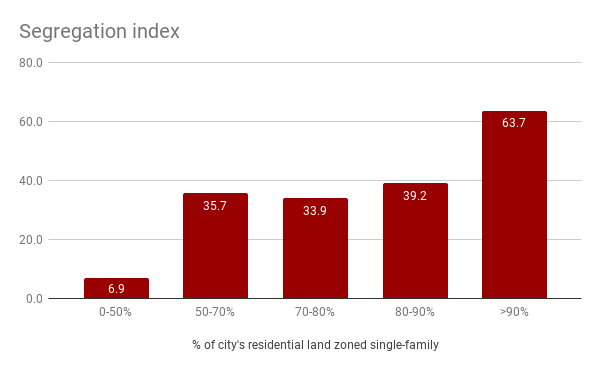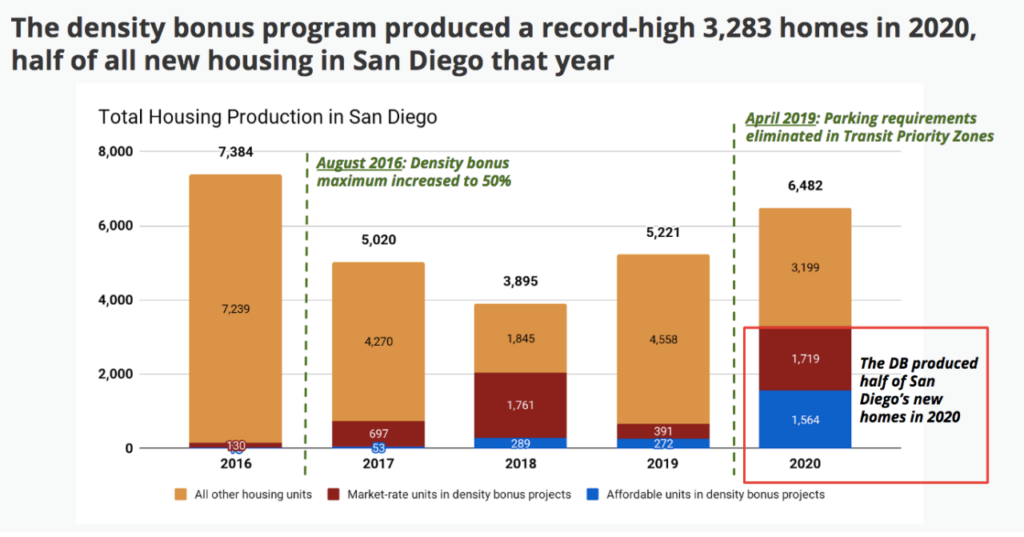What City Observatory this week
1. Why highway departments can and should build housing to mitigate road damage. For decades, American cities have been scarred and neighborhoods destroyed by highway construction projects. Many places are contemplating measures to fix these problems, from freeway removals to pledges of “restorative justice.” Given that highways directly and indirectly triggered the demolition of tens of thousands of homes in the nation’s cities, the most tangible way a highway department can repair the damage it did is not with vague pledges, but by paying to build more housing. That’s exactly what some state DOTs, including Texas, Kentucky, and Nevada are doing. The Federal Highway Administration has recognized as an award-winning best practice a project in Lexington Kentucky which is using highway funds to buy 25 acres of land and capitalize a community land trust to build 100 new homes to offset the damage done to an historically Black neighborhood that was decimated by the threat of highway construction. For decades, highway departments demolished homes; a step toward restorative justice would be putting some of them back.
2. The toll of Single Family Zoning: Part 1: We are pleased to publish a guest commentary from Anthony Dedousis of Abundant Housing LA, exploring the relationship between single-family zoning and socioeconomic indicators across the 88 cities in L.A. County. This policy bans the construction of apartments, which reduces the amount of housing and raises the cost of living. Apartment bans are rampant in L.A. County, with the median city zoning over 80% of the land for single-family housing. Using data from the South California Association of Governments and the America Community Survey, Dedousis finds that median household incomes, median housing costs, and homeownership rates tend to be higher in cities with a greater prevalence of single-family zoning.
It is clear that there is a positive association between the city’s socioeconomic makeup and apartment bans. Nearly every city with high median incomes similarly has high rates of single-family zoning. Limiting the stock of housing in a city presents a barrier to renter households and low- to moderate-income individuals from accessing affordable housing in these high-opportunity cities. This analysis provides clear evidence that apartment bans by suburban cities are a principal mechanism for creating and maintaining economic segregation in US metro areas.
3. The toll of Single Family Zoning: Part 2: Single family zoning doesn’t just segregate the population by income, it’s a key ingredient in the persistennce of racial and ethnic segregation in US Metro areas. In part 2 of his analysis of variations in zoning and demographics among Los Angeles County cities, Anthony Deodousis examines the correlations between the amount of land a city zones for single family housing and its racial and ethnic composition. Not surprisingly, he finds that cities that zone more land for single family housing are more highly segregated than those with more land for multi-family housing.
Perhaps the most striking finding is illustrated in this chart with shows the segregation index (a measure of how racially and ethnically segregated a city is, higher values correspond to higher levels of segregation) and the percent of residential land designated for single family use. Cities that designate 90 percent or more of their residential land area to single family homes have a segregation index ten times higher than those than designate half or less of their land for single family homes. It’s a compelling illustration of the connection between single family zoning and segregation.
Must read
1. Business as usual: The Senate Highway Reauthorization bill: Just ignore the high minded rhetoric about dealing with climate change and “fix it first” policies for roads, the US Senate is all in on simply pumping even more money into a failed highway-industrial complex. The latest evidence of this comes from the newly passed highway reauthorization bill emerging from a key Senate Committee this week. Transportation for AMerica’s Beth Osborne bluntly catalogs the implications:
“The status quo is sending us backwards: This bill attempts to solve the problems of the transportation system with small, underfunded new programs while spending way more to continue to churn out those same problems. It allows states to opt out of lowering carbon emissions and continues to support strategies that are well known to raise them. We don’t have time for another five years of creating more problems that will take 20 to 50 years to solve.
While President Biden’s American Jobs Plan, which would at least attempt to tackle climate issues flounders in a desperate attempt to be bipartisan, this deeply flawed reauthorization measure passed with a unanimous vote. It’s symbolic of how deeply this malignant highway building pathology is lodged in the body politic.
2. Weighing in on Infrastructure Policy. The Washington Post weighs in on the debate over the nation’s infrastructure policy with a helpful, fact-based article looking at the highway maintenance backlog in contrast to state spending priorities. They report that the nation faces a $435 billion rehabilitation backlog, and that a fifth of the nation’s major road are in poor condition, and that little progress has been made in reducing the maintenance backlog. At the same time, state’s have spent nearly a third of their roadway capital on expanding roads rather than maintaining the one’s they’ve already built.
State’s rationalize system expansion on the theory that it will reduce traffic congestion, but as long-time City Observatory readers will know, that’s a false hope. More capacity begets more traffic, quickly erasing any performance gains. The Post cites UC Davis transport expert Susan Handy on the implications of induced demand:
For decades, researchers have found that when roads get wider, people tend to drive more, ultimately canceling out any gains in speed. Susan Handy, a professor of environmental science and policy at the University of California at Davis, said traditional tools for forecasting traffic demand to assess the benefits of new construction don’t effectively take that into account. Researchers noted that traffic eventually increases by about the same percentage a road is widened, so boosting the size of a road by 10 percent will lead to about 10 percent more travel.
3. Don’t use parking requirements as a bargaining chip for affordable housing. It is widely recognized that parking requirements tend to drive up the cost of housing, but many housing advocates will often fight to retain parking requirements in order to barter them away to persuade developer to build affordable housing units. The results of a quasi-experiment in San Diego show that this approach is a bad bargain for promoting affordability. It turns out that simply eliminating or greatly reducing parking requirements has a more positive effect on housing supply and therefore rental affordability than a complex system of negotiated land use approvals using parking space waivers as bargaining chips.
in 2020, one year after comprehensive parking reform was implemented, there was a fivefold increase in the total number of homes permitted through San Diego’s density bonus program. A record-high 3,283 homes were built using the density bonus in 2020 — nearly half of all new housing permitted in the city that year. Total housing production citywide also rose, by 24 percent. More use of the density bonus program also translated into more affordable units. The program produced over 1,500 affordable homes in 2020 – six times more than in 2019. Between 2016 and 2019, the program had never produced more than 300 affordable homes in one year.
New Knowledge
Synthetic microdata: A threat to knowledge. Each week at City Observatory, we usually profile an interesting or provocative research study. This week, we’re spending a minute to highlight a potential threat to a key source of data that helps us better understand our world, and especially the nation’s cities: the public use microsample of the American Community Survey (ACS). The ACS is the nation’s largest and most valuable source of data on population, housing, social and economic characteristics. While the Census Bureau produces many tabulations of these data, its impossible to slice and dice data in a way that bears on every question. So Census Bureau makes available what is called a “public use microsample” which allows researchers to craft their own customized tabulations of these data to answer specific questions. At City Observatory, for example, we’ve used these data to estimate the income, race and ethnicity of peak hour drive alone suburban commuters traveling from suburban Washington State to jobs in Oregon–a question that would be essentially impossible to answer from either published Census tabulations or other publicly available data.
Microdata are valuable because they link answers to different ACS questions–linking a persons age, gender or race to their income, occupation or housing type, and on. But because the microdata are individual survey responses, some are concerned that there’s a potential violation of privacy: that someone could use answers to a series of questions to deduce the identity of an individual survey respondent. While that may technically be a possibility, there’s no evidence it occurs in practice. Still, Census Bureau is hypersensitive about privacy concerns, and has proposed replacing actual microdata with “synthetic” microdata, in order to make it even more difficult to identify an individual. Essentially, synthetic data would replace actual patterns of responses with statistically modeled responses. The trouble is, this modeled, synthetic data actually subtracts information, and makes it impossible for researchers to know whether the answers to any particular question are a product of actual variation, or just a quirk of Census Bureau’s model. As University of Minnesota data expert Stephen Ruggles puts it, “synthetic data will be useless for research.”
The privacy threat from ACS microdata is a phantom menace. Ruggles and a colleague at the University of Minnesota have just published a paper showing that attempting to use Census microdata to create individually identifiable records via database reconstruction would produce vastly more random (i.e. false) matches that real ones. This undercuts the idea that microdata is an actual threat to privacy.
But a proposal to replace PUMS data with synthetic data is a real threat to our ability to better understand our world. It is like requiring piano players to wear mittens when playing Beethoven sonatas: the piano will still produce sound, but the result will be noise, not music.
Mike Schneider, Census Bureau’s use of ‘synthetic data’ worries researchers, Some researchers are up in arms about a U.S. Census Bureau proposal to add privacy protections by manipulating numbers in the data most widely used for economic and demographic research, ABC News, May 27, 2021
Steven Ruggles and David VAn Piper, “The Role of Chance in the Census Bureau Database Reconstruction Experiment,” University of Minnesota, May 2021 Working Paper No. 2021-01 DOI: https://doi.org/10.18128/MPC2021-01
In the News
Bloomberg Business Week quoted City Observatory’s Joe Cortright in its article examining the Biden Administration’s housing policy.
Oregon Public Broadcasting cited Joe Cortright’s analysis of road pricing in its story on highway expansion and tolling legislation currently being considered by the Oregon Legislature.





